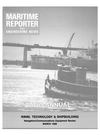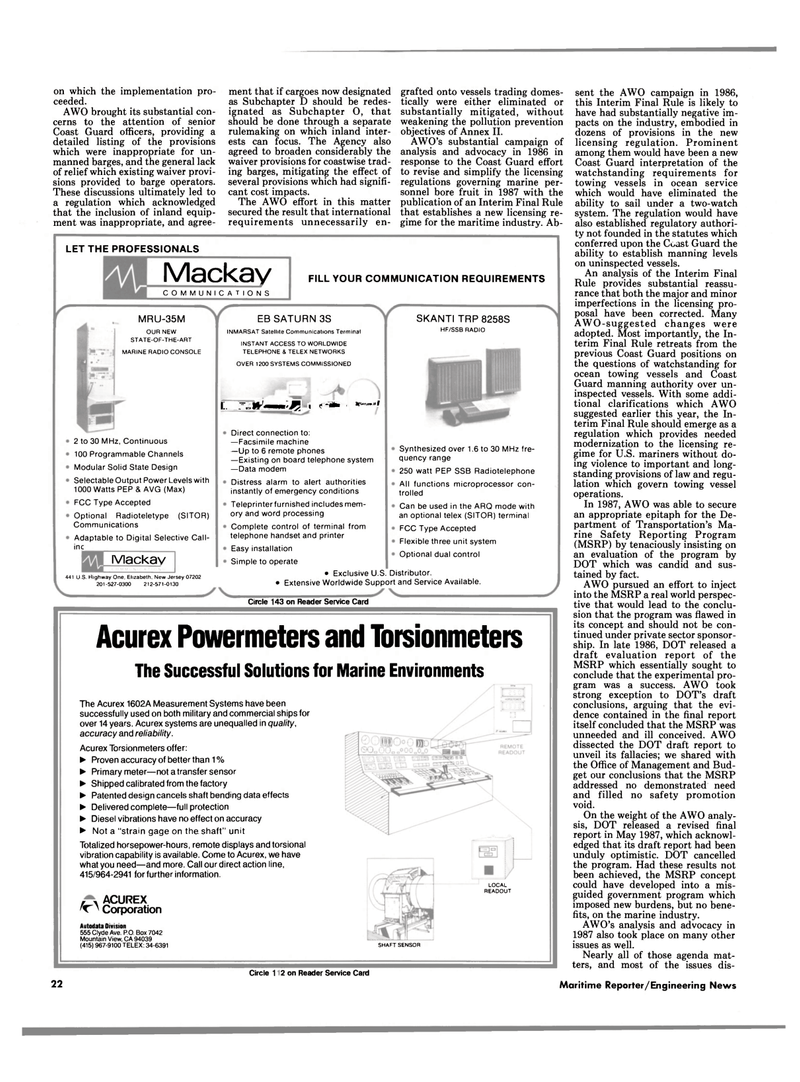
Page 20: of Maritime Reporter Magazine (March 1988)
Read this page in Pdf, Flash or Html5 edition of March 1988 Maritime Reporter Magazine
on which the implementation pro- ceeded.
AWO brought its substantial con- cerns to the attention of senior
Coast Guard officers, providing a detailed listing of the provisions which were inappropriate for un- manned barges, and the general lack of relief which existing waiver provi- sions provided to barge operators.
These discussions ultimately led to a regulation which acknowledged that the inclusion of inland equip- ment was inappropriate, and agree- ment that if cargoes now designated as Subchapter D should be redes- ignated as Subchapter 0, that should be done through a separate rulemaking on which inland inter- ests can focus. The Agency also agreed to broaden considerably the waiver provisions for coastwise trad- ing barges, mitigating the effect of several provisions which had signifi- cant cost impacts.
The AWO effort in this matter secured the result that international requirements unnecessarily en- grafted onto vessels trading domes- tically were either eliminated or substantially mitigated, without weakening the pollution prevention objectives of Annex II.
AWO's substantial campaign of analysis and advocacy in 1986 in response to the Coast Guard effort to revise and simplify the licensing regulations governing marine per- sonnel bore fruit in 1987 with the publication of an Interim Final Rule that establishes a new licensing re- gime for the maritime industry. Ab-
LET THE PROFESSIONALS
Mackay
COMMUNICATIONS
FILL YOUR COMMUNICATION REQUIREMENTS
MRU-35M
OUR NEW
STATE-OF-THE-ART
MARINE RADIO CONSOLE 2 to 30 MHz, Continuous 100 Programmable Channels
Modular Solid State Design
Selectable Output Power Levels with 1000 Watts PEP & AVG (Max)
FCC Type Accepted
Optional Radioteletype (SITOR)
Communications
Adaptable to Digital Selective Call- inc
Mackay
EB SATURN 3S
INMARSAT Satellite Communications Terminal
INSTANT ACCESS TO WORLDWIDE
TELEPHONE & TELEX NETWORKS
OVER 1200 SYSTEMS COMMISSIONED i! . ,¥r J^i ( *»«•»» i 441 U.S. Highway One. Elizabeth. New Jersey 07202 201-527-0300 212-571-0130
Direct connection to: —Facsimile machine —Up to 6 remote phones —Existing on board telephone system —Data modem
Distress alarm to alert authorities instantly of emergency conditions
Teleprinterfurnished includes mem- ory and word processing
Complete control of terminal from telephone handset and printer
Easy installation
Simple to operate • Exclusive U.S. Distributor. • Extensive Worldwide Support and Service Available.
SKANTI TRP 8258S
HF/SSB RADIO
Synthesized over 1.6 to 30 MHz fre- quency range 250 watt PEP SSB Radiotelephone
All functions microprocessor con- trolled
Can be used in the ARQ mode with an optional telex (SITOR) terminal
FCC Type Accepted
Flexible three unit system
Optional dual control
Circle 143 on Reader Service Card
Acurex Powermeters and Torsionmeters
The Successful Solutions for Marine Environments
The Acurex 1602A Measurement Systems have been successfully used on both military and commercial ships for over 14 years. Acurex systems are unequalled in quality, accuracy and reliability.
Acurex Torsionmeters offer: • Proven accuracy of better than 1 % • Primary meter—not a transfer sensor • Shipped calibrated from the factory • Patented design cancels shaft bending data effects • Delivered complete—full protection • Diesel vibrations have no effect on accuracy • Not a "strain gage on the shaft" unit
Totalized horsepower-hours, remote displays and torsional vibration capability is available. Come to Acurex, we have what you need—and more. Call our direct action line, 415/964-2941 for further information.
ACUREX w Corporation
Autodata Division 555 Clyde Ave. P.O. Box 7042
Mountain View, CA 94039 (415) 967-9100 TELEX: 34-6391
LOCAL
READOUT
SHAFT SENSOR . . Circle 152 on Reader Service Card sent the AWO campaign in 1986, this Interim Final Rule is likely to have had substantially negative im- pacts on the industry, embodied in dozens of provisions in the new licensing regulation. Prominent among them would have been a new
Coast Guard interpretation of the watchstanding requirements for towing vessels in ocean service which would have eliminated the ability to sail under a two-watch system. The regulation would have also established regulatory authori- ty not founded in the statutes which conferred upon the Coast Guard the ability to establish manning levels on uninspected vessels.
An analysis of the Interim Final
Rule provides substantial reassu- rance that both the major and minor imperfections in the licensing pro- posal have been corrected. Many
AWO-suggested changes were adopted. Most importantly, the In- terim Final Rule retreats from the previous Coast Guard positions on the questions of watchstanding for ocean towing vessels and Coast
Guard manning authority over un- inspected vessels. With some addi- tional clarifications which AWO suggested earlier this year, the In- terim Final Rule should emerge as a regulation which provides needed modernization to the licensing re- gime for U.S. mariners without do- ing violence to important and long- standing provisions of law and regu- lation which govern towing vessel operations.
In 1987, AWO was able to secure an appropriate epitaph for the De- partment of Transportation's Ma- rine Safety Reporting Program (MSRP) by tenaciously insisting on an evaluation of the program by
DOT which was candid and sus- tained by fact.
AWO pursued an effort to inject into the MSRP a real world perspec- tive that would lead to the conclu- sion that the program was flawed in its concept and should not be con- tinued under private sector sponsor- ship. In late 1986, DOT released a draft evaluation report of the
MSRP which essentially sought to conclude that the experimental pro- gram was a success. AWO took strong exception to DOT's draft conclusions, arguing that the evi- dence contained in the final report itself concluded that the MSRP was unneeded and ill conceived. AWO dissected the DOT draft report to unveil its fallacies; we shared with the Office of Management and Bud- get our conclusions that the MSRP addressed no demonstrated need and filled no safety promotion void.
On the weight of the AWO analy- sis, DOT released a revised final report in May 1987, which acknowl- edged that its draft report had been unduly optimistic. DOT cancelled the program. Had these results not been achieved, the MSRP concept could have developed into a mis- guided government program which imposed new burdens, but no bene- fits, on the marine industry.
AWO's analysis and advocacy in 1987 also took place on many other issues as well.
Nearly all of those agenda mat- ters, and most of the issues dis- 22 Maritime Reporter/Engineering News

 19
19

 21
21
